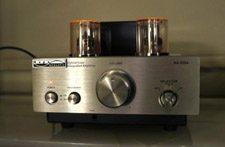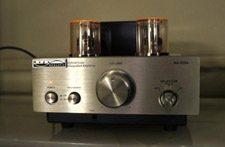

 I'm a closet tube freak and, while much of my day may be spent extolling the virtues of solid state devices and/or the latest video technology, I jump on any chance I get to spend time with tubes. Following this year's CES show in Vegas, I came away with two such tube products that I had to review, the first being Napa Acoustic's NA-208A Integrated Amplifier. At $399 direct, the NA-208A was among the most affordable products I laid eyes on at the show and, if I'm honest, one of the more impressive, too.
I'm a closet tube freak and, while much of my day may be spent extolling the virtues of solid state devices and/or the latest video technology, I jump on any chance I get to spend time with tubes. Following this year's CES show in Vegas, I came away with two such tube products that I had to review, the first being Napa Acoustic's NA-208A Integrated Amplifier. At $399 direct, the NA-208A was among the most affordable products I laid eyes on at the show and, if I'm honest, one of the more impressive, too.
Additional Resources
• Read more stereo amplifier reviews from HomeTheaterReview.com's staff.
• Explore more audiophile products at AudiophileReview.com.
• Learn about The Evolution of the Two-Channel Preamp.
The NA-208A is a desktop integrated amp, if you will, in that it sports a rather compact footprint, measuring seven inches wide by nine-and-a-half inches deep and a mere five inches in tall. The weight of the NA-208A is not given, but it's substantial enough to exude a sense of quality despite its compact stature and Made in China pedigree. The NA-208A is a hybrid vacuum tube design, as it uses two 6N1 tubes in its input stage coupled with a solid state output or power stage, making it good for 25 watts into six ohms. The tubes are auto-biasing and come already installed in their appropriate sockets, encased in thin plastic that helps guide the orange accent light upward. The front of the NA-208A is clad in thick aluminum, with controls for power, bass boost and input selection, not to mention volume, which is located dead center of the front panel by way of a large polished dial. Below the aluminum façade rests what appears to be nothing more than a matte black platform, except for the fact that it houses the unit's mini-aux input. Speaking of inputs, the NA-208A has several, the first being its mini-aux jack, followed by two pairs of unbalanced analog audio inputs -one for CD, the other for aux. Below the two analog inputs rests a single USB input for connecting your iPod, iPhone or iPad. The NA-208A comes complete with a USB-to-iProduct cable, as well as a rubber cradle of sorts to hold said iDevice. Resting in the middle of the NA-208A's back panel are its two pairs of five-way-like binding posts. I say five-way-like, because they're not large enough to accept anything short of very narrow gauge bare wire or wire terminated with old-school pin adaptors. There is an attached power cord, but no remote.
As I stated earlier, the NA-208A's rated power output is said to be 25 watts into six ohms, with total harmonic distortion coming in at less than one percent. Its bass boost feature is reported to give a plus-six dB boost in the lower frequencies, though its frequency response is listed at 20Hz to 20kHz. So while the NA-208A isn't a juggernaut in terms of power, it should drive a pair of inexpensive bookshelf or floor-standing speakers just fine, provided a) they're relatively efficient and b) your room isn't on the large side. For the purposes of my demo, I used the NA-208A to drive a pair of Episode 900 Series monitor loudspeakers with satisfactory results.
In terms of sound, I must say the NA-208A is surprising, possessing all the traits one normally associates with tubes - liquidity, texture, warmth and dimension - without seeming lush or overly warm. In fact, I was quite surprised by the NA-208A's speed. While I wouldn't classify it as hugely dynamic, which may have more to do with my speaker choice than the amp's ability, its resolution, specifically in the leading and trailing edges of notes, was surprising. My reference standard for neutrality, speed and effortless musicality at or near the NA-208A's price is still Decware's single-ended triode amplifiers. While the NA-208A didn't quite best the Decware's sound, its increased power and ability to connect to a wider variety of source components more than made up for what it lacked sonically. In all truthfulness, there were a number of similarities between the two amplifiers' sound that I wasn't expecting and both were enjoyable, provided I didn't crank the volume too much. As part of a desktop or nearfield setup, the NA-208A should be enough amplifier for anyone, but if you plan on installing it into a more traditional system in a room of average to moderate size, I'm afraid the NA-208A is going to disappoint. I paired it with Napa Acoustic's NA-208C CD player, which just so happens to share the same chassis and compact footprint, and found the two to be a match made in affordable audiophile heaven.
Read about the high points and low points of the Napa Acoustic NA-208A on Page 2. High Points
High Points
• Despite its Made in China credentials, the
NA-208A is a well-built, nicely appointed and almost tailored-looking
piece. While I found the faux orange up-lighting to be a bit cheesy, my
wife really liked it, for the input tubes didn't glow bright enough for
her tastes.
• The number of connection options the NA-208A affords
you is rather surprising, not only at this price point, but also given
the size of its chassis. Those of you who like to listen to music via
your iPhone or iPod will be well served by the NA-208A, for it not only
interfaces seamlessly with your iProducts, it also manages to make
lower-resolution music more enjoyable.
• Despite having only 25
watts at its disposal, the NA-208A is capable of powering bookshelf and
modest floor-standing speakers to satisfying levels - though if you
fancy yourself a head banger, you should probably look elsewhere.
•
When paired with the matching NA-208C CD player, the NA-208A becomes the
heart and soul of a very musically satisfying and engaging audiophile
system on the cheap.
Low Points
• I really hope Napa Acoustic
addresses the NA-208A's binding posts, for they're pretty bad and
nearly ruin what is a fun little amplifier. The only cables I had on
hand that would fit the NA-208A's miniscule posts were Mapleshade's
Clearview speaker cables, which are far narrower than most generic lamp
cord. I'm told Napa Acoustic will be looking into this issue in the near
future.
• I wish the NA-208A had a remote, if for no other reason
than the matching CD player has one, though those installing their
NA-208A on their desktops, a remote may be a bit of a moot point.
• The NA-208A will not charge your connected iDevice while it is connected to the amp via its include HDMI to iConnector cable.
Competition and Comparison
There
aren't a significant number of tube integrated amps that can be had for
as little as $399 like the NA-208A -at least, not that I'm aware of.
That being said, there are some that are worth mentioning, should you be
looking for something a bit different or are willing to spend just a
little more.
For starters, there is my personal favorite,
Decware's SE84C+ Zen Triode Stereo Amplifier. Decware's "Zen" amp sells direct for $775, is handmade right here in
the United States, and comes with a lifetime warranty to the original
purchaser. The Zen is also down on power, compared to the NA-208A,
offering up a mere two watts, which makes it ideal for only
super-efficient loudspeakers, like those from Tekton Design, Parker Audio, or even Decware themselves. Do I consider the Zen to be a better amp? Yes, but the NA-208A is
more versatile and probably better suited for casual listeners or
first-time tube buyers.
Another amplifier company to consider
would be Jolida, which like the NA-208A, sells Chinese-made amps, though
they too pack quite a bit of performance into their modest price tags.
The amp most like the NA-208A, going off specifications alone, would be
Jolida's FX 10 integrated amplifier at $499. I have not personally
demoed the FX 10, though have heard from those who have and many
consider it to be a very competent little tube amp.
For more
information on tube amps and/or integrated amps, please visit Home
Theater Review's Stereo Amplifier page.
Conclusion
I can't tell you the last time I had this much
fun just messing around with inexpensive gear and enjoying some tunes
in the process. The NA-208A from Napa Acoustic isn't the last word or
authority on anything except perhaps fun, for it's one of the least
complicated yet fully appointed tube preamps I've ever had the privilege
to spend time with, and yet it doesn't cost a fortune. When mated to
modest speakers of slightly high efficiency (90dB or better), the
NA-208A is more than capable of sonic feats you would have thought would
cost you more. Mate the NA-208A with its matching CD player and a pair
of small bookshelf speakers like Wharfedale's new Jade 1s, and you'll
have a modestly-priced (under $2,000) two-channel system that will
provide you with years of enjoyment. Honestly, I'd score the NA-208A
higher in terms of its performance if I didn't find its binding posts to
be so limiting. Still, I recommend checking it out for yourself.
Additional Resources
• Read more stereo amplifier reviews from HomeTheaterReview.com's staff.
• Explore more audiophile products at AudiophileReview.com.
• Learn about The Evolution of the Two-Channel Preamp.